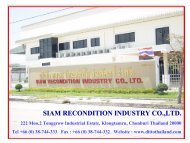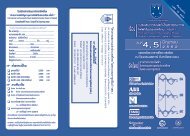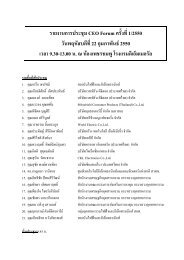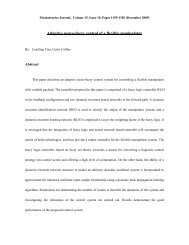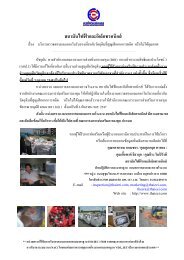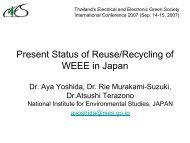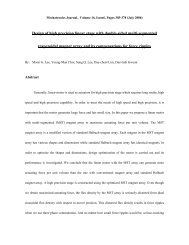Environmental and Energy Management in a Textile Dyeing ... - IGES
Environmental and Energy Management in a Textile Dyeing ... - IGES
Environmental and Energy Management in a Textile Dyeing ... - IGES
Create successful ePaper yourself
Turn your PDF publications into a flip-book with our unique Google optimized e-Paper software.
Cleaner technology implementation<br />
Introduction of cleaner technology<br />
In the first stage, the company participated <strong>in</strong> a project called “Promotion of Cleaner<br />
Technology <strong>in</strong> Thail<strong>and</strong>,” implemented by the Thail<strong>and</strong> Environment Institute (TEI) with<br />
support from the Danish Cooperation for Environment <strong>and</strong> Development (DANCED) <strong>and</strong><br />
Federal of Thai Industries (FTI). The project focused on water <strong>and</strong> energy conservation<br />
options for implementation <strong>in</strong> the <strong>in</strong>itial stages, as follows:<br />
• replac<strong>in</strong>g worn out pipes;<br />
• <strong>in</strong>stall<strong>in</strong>g steam pip<strong>in</strong>g <strong>in</strong>sulation;<br />
• enhanc<strong>in</strong>g boiler efficiency; <strong>and</strong><br />
• implement<strong>in</strong>g simple good housekeep<strong>in</strong>g<br />
practices such as <strong>in</strong>stall<strong>in</strong>g water meters,<br />
level controllers, <strong>and</strong> flow control nozzles.<br />
Source: Tittaya Waranusantikule, TEI<br />
St<strong>and</strong>ardisation of color-match<strong>in</strong>g procedures.<br />
The company participated <strong>in</strong> the Research Cooperation Project on<br />
Dye<strong>in</strong>g <strong>and</strong> F<strong>in</strong>ish<strong>in</strong>g Industries <strong>in</strong> Thail<strong>and</strong> by Technology of Cleaner<br />
Production, supported by the New <strong>Energy</strong> <strong>and</strong> Industrial Technology<br />
Development Organisation (NEDO), Japan, <strong>and</strong> the Department of<br />
Industrial Promotion (DIP). The project aims to elim<strong>in</strong>ate the re-dye<strong>in</strong>g<br />
process by improv<strong>in</strong>g work<strong>in</strong>g procedures for staff <strong>and</strong> us<strong>in</strong>g<br />
computerised match<strong>in</strong>g devices.<br />
Accurately match<strong>in</strong>g colours is vitally important to the<br />
quality of products. In the project’s implementation, an<br />
expert from Kurabo Industry Company, Japan, conducted a<br />
short-term study to identify opportunities for improvement<br />
<strong>in</strong> the work<strong>in</strong>g procedures of laboratory staff. It was found<br />
that the quality of the colour-match<strong>in</strong>g process was ma<strong>in</strong>ly<br />
based on staff experience. It was also found that factors<br />
affect<strong>in</strong>g the end-result of match<strong>in</strong>g, such as temperature <strong>and</strong><br />
Source: Tittaya Waranusantikule,<br />
TEI<br />
water volume, were not properly controlled, which led to<br />
errors <strong>in</strong> colour match<strong>in</strong>g.<br />
Consequently, st<strong>and</strong>ardised work<strong>in</strong>g procedures, such as measur<strong>in</strong>g <strong>in</strong>strument selection <strong>and</strong><br />
solution preparation, were <strong>in</strong>troduced to ensure more accurate colour match<strong>in</strong>g. In order to<br />
improve work<strong>in</strong>g procedures, laboratory staff were tra<strong>in</strong>ed on how to achieve uniform colour<br />
mixtures. Work<strong>in</strong>g conditions were also carefully controlled; a highly sensitive weightmeasur<strong>in</strong>g<br />
device was moved to an air-conditioned room to avoid disturbances from electric<br />
fans, <strong>and</strong> a computerised colour-match<strong>in</strong>g device was <strong>in</strong>stalled <strong>in</strong> order to enhance match<strong>in</strong>g<br />
efficiency.<br />
Boiler <strong>and</strong> steam trap retrofit<br />
Steam is one of the necessary results of the heat transfer process.<br />
The factory periodically conducts an energy audit <strong>and</strong><br />
benchmark<strong>in</strong>g to monitor <strong>in</strong>efficiencies <strong>in</strong> the process.<br />
Consequently, top management decided to participate <strong>in</strong> the<br />
Steam System Project <strong>in</strong> order to improve energy efficiency <strong>in</strong><br />
the steam generat<strong>in</strong>g <strong>and</strong> recovery system. This development by<br />
S<strong>in</strong>saenee Company was selected as a pilot project for steam<br />
trap <strong>in</strong>stallation. The steam trap is an automatic valve that<br />
catches <strong>and</strong> releases condensate <strong>in</strong>to the pip<strong>in</strong>g systems, thus<br />
prevent<strong>in</strong>g the release of steam <strong>and</strong> ventilat<strong>in</strong>g air <strong>in</strong>to the<br />
system.<br />
Source: Tittaya Waranusantikule,<br />
TEI<br />
2



